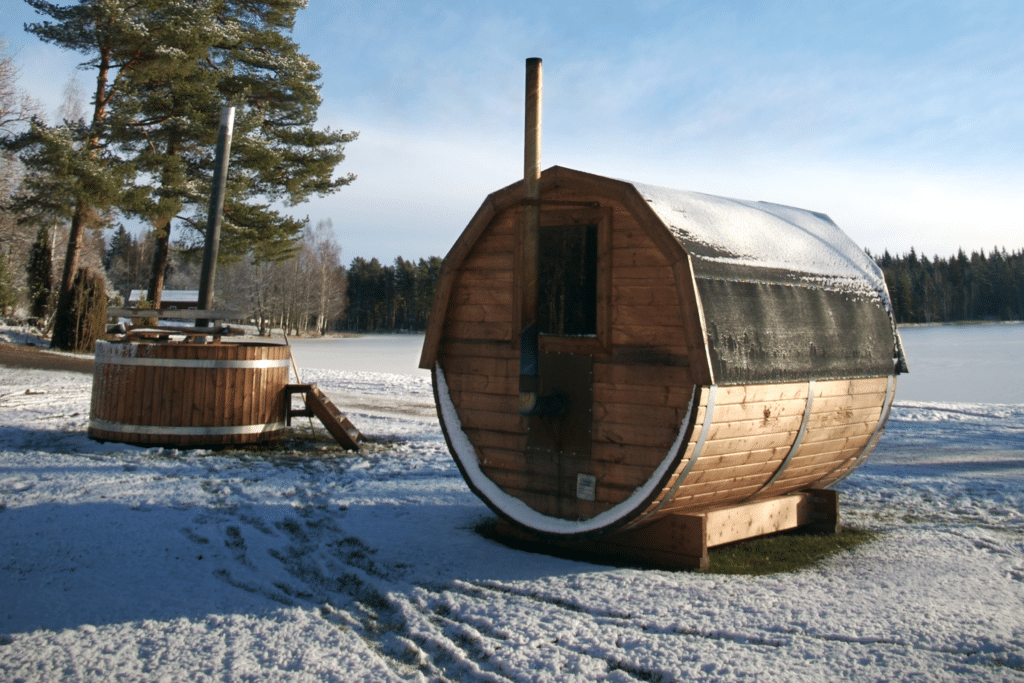There are three main types of saunas: traditional dry saunas, infrared saunas, and steam saunas. Although the experiences are similar, there are some key differences. So, what is a dry sauna, anyway?
A dry sauna uses a heat source, such as a wood-burning stove or stone compartment powered by gas or electricity, to raise the room’s temperature. Usually, dry saunas are about 173°F and have less than 10% humidity. Their main benefits include detoxification, better stress management, and improved respiratory function.
These types of saunas are best suited for toxin removal through sweating and reducing Delayed Onset Muscle Soreness (or DOMS).
Keep reading to learn more about a traditional dry sauna, how it works, what differentiates it from other types of saunas, and the potential benefits of using one!
What is a traditional dry sauna?
The idea of a traditional dry sauna, otherwise known as a “Finnish” sauna, originated in northern Europe around 2,000 BC.
Today, dry saunas utilize a heat source, like a wood-fired stove or stones in a natural gas or electrical heating container, to raise the temperature of the air in the room and, with it, your core body temperature. Typically, the average temperature of a dry sauna is around 173°F with a humidity level below 10%.
Most people spend around 20 minutes inside, although you only need 15 minutes of exposure to reap maximum benefits like detoxification, relaxation, and improved cardiovascular function.
Experts recommend visiting the sauna 3 times per week in 15-minute sessions to see tangible, long-term results.

How does a dry sauna work?
As we mentioned above, a few different heating elements can be used in a dry sauna.
Using a wood-burning stove, logs of wood are thrown into a compartment, much like a fireplace, to generate heat. More commonly, stones in an electric or natural gas heating container are used. These stones are thermally conductive; essentially, they absorb heat, then slowly release it back into the air to warm the sauna.
Igneous rocks, like granite, are a great option due to their ability to retain energy and maintain a steady temperature within the sauna. Furthermore, you can ladle water on top of the rocks to cool down the room and release more moisture into the air.
Want to know more about what kinds of rocks are best in your sauna? Check out this article!
Important note: Always opt for a non-porous type of rock that will repel water. Absorbent materials can shatter when exposed to high temperatures.
What is the point of a dry sauna?
Traditional dry saunas are multi-functional.
They help us relax after a long day, expel toxins like lactic acid following an intense workout, or boost our brain function by releasing essential hormones. Overall, dry saunas are a wellness mechanism that, when incorporated correctly, can produce many health benefits that promote longevity.
We’ll get a bit more granular below.
Dry sauna vs. wet (steam) saunas
While dry saunas serve a similar purpose as steam saunas, there are some key differences. So, what is a wet sauna, anyway?
Dry sauna temperatures are hotter, with lower levels of humidity, and are usually made of wood. Wet (steam) saunas, on the other hand, are around 115°F, have 100% humidity by using a steam generator and are composed of tile or glass that resists moisture damage.
Steam rooms often feel much hotter than saunas because the air is thicker due to the high humidity levels. It’s not uncommon for people to alternate between a dry sauna and a wet sauna to challenge their bodies to withstand both!
Is a wet or dry sauna better?
The million-dollar question is: which one is better?
Wet and dry saunas have different purposes and risks, so your preference will depend on your specific needs and any potential health concerns. Steam saunas are better for clearing your sinuses after a cold or improving skin health. Alternatively, dry saunas are much more efficient at penetrating deep muscles and promoting toxin removal through sweating.
Before selecting the appropriate sauna for your needs, decide what you’re trying to achieve then keep reading to find out which one will meet your needs!
Dry sauna vs. infrared saunas
Traditional dry saunas feel much more similar to infrared saunas than steam rooms, but there are some fundamental distinctions between the two.
Infrared saunas use infrared light waves to emit direct heat to the body in order to raise its core temperature, rather than increasing the air temperature as dry saunas do. Additionally, infrared saunas are around 130ºF and have virtually no humidity.
The benefits of this type of sauna include pain relief and improved circulation through deep tissue penetration.
Is a dry sauna or infrared sauna better?
If you compare dry sauna vs infrared sauna – which one is better for you?
Like a wet sauna, each has its own set of applications, pros, and cons. However, infrared saunas are much more comfortable to withstand and deliver quicker results due to the way they heat your body from the inside out.
As with any type of sauna, the same risks of dehydration apply.
How to use a dry sauna
Part of experiencing the potential benefits of a dry sauna requires proper use.
The best practices for using a traditional dry sauna include:

Continue to drink water after your session to promote further detoxification and reduce dehydration.
Do you wear clothes in a dry sauna?
Are clothes a necessary part of visiting the sauna?
While you don’t need to wear clothes in gender-specific dry saunas, it’s often a common courtesy to do so. You will need to lay a clean towel to sit on, and most people at least wear a towel around their waist or chest. If you do wear clothes inside, opt for loose-fitting pieces that allow your skin to breathe and limit rashes.
Permeable fabrics like cotton are a good option. Shoes aren’t essential, but some sauna bathers wear flip-flops or rubber sandals to reduce the spread of bacteria.
Potential benefits of a traditional dry sauna
There are many advantages to using a traditional dry sauna regularly. So, what is a dry sauna good for, and how can it help you?

Let’s dive into these benefits in more detail!
Detoxification

Sweating is one of the main outcomes of using a dry sauna. In fact, that’s most people’s ultimate goal!
Harmful toxins like heavy metals and bisphenol A (BPA) can accumulate in our body’s fat storage or bloodstream. Our sweat glands are able to remove these toxins during sauna bathing.
This type of buildup can cause serious physiological damage and, in the worst case, even cancer. Read here about how saunas help remove toxins and cleanse the body and mind.
Improved blood circulation

Using a dry sauna increases blood flow throughout your body.
The increase in blood circulation is beneficial to your health in a variety of ways. It allows your organs to function more effectively and enables any wounds or injuries to heal faster.
Furthermore, it promotes good skin health by ensuring that the reticular and papillary layers of the dermis receive adequate blood flow to stimulate epidermal cell turnover.
Better stress management

Stress is a combination of mental and physical strain on our bodies.
When our bodies are stressed, cortisol floods our bloodstream. While cortisol levels usually spike during sauna use, afterward, these levels drop by about 25%.
Lowering stress levels is necessary to meet weight loss goals, achieve balanced hormones, and maintain a healthy equilibrium.
Pain reduction and quicker healing

Heat therapy can relieve muscle soreness and stiffness better than almost any other treatment.
Dry sauna exposure has been shown in studies to speed up the healing of connective tissues, allowing for faster muscle recovery after a workout.
This is a critical part of building muscle and seeing faster results in the gym.
Improved respiratory function

Sauna bathing has the ability to strengthen respiratory function over time.
Furthermore, it can actually enhance breathing in people that suffer from chronic respiratory problems like asthma and allergies. To help increase the strength of your lungs, use breathing techniques, like the Box Breathing Method, while inside.
Check out this article for everything you need to know about the Box Breathing Method, plus several other meditation exercises you can do in the sauna.
If you have an acute, severe respiratory illness, avoid the sauna until your doctor clears you.


